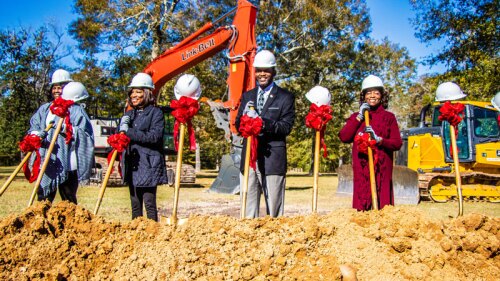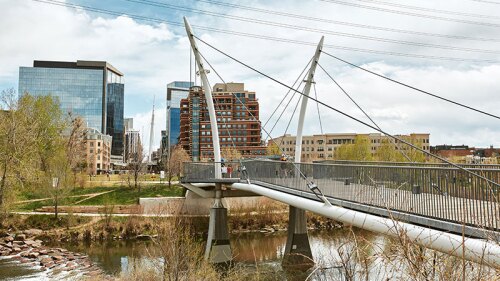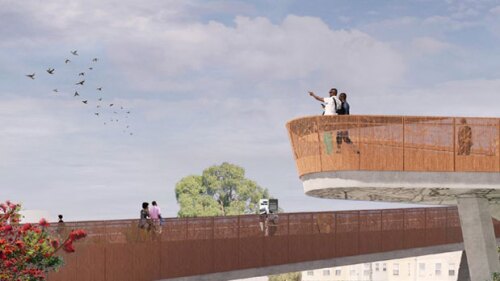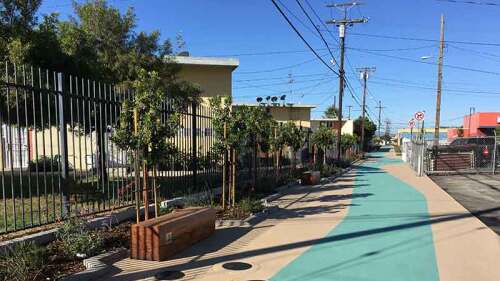Museums, theaters, even a whitewater training facility can help draw young creative people to a city.
| Charlotte’s Mint Museum Uptown in the center city holds |
When individuals and companies look to relocate, quality of life, as measured by access to the arts, culture, and recreation, can be key to their decision making. This fact has not been lost on the leaders of Charlotte, North Carolina, who have spent the past two decades building a more livable city. While their initial intent has certainly been to provide for the needs of residents, an equally important goal has been to build the amenities that attract and retain a young and creative workforce whose members demand a rich life outside of work.
From 1976 to 2001, the city of Charlotte and Mecklenburg County partnered with local arts organizations, the city’s big banks, Duke Energy, local foundations, and philanthropists to build $200 million in cultural facilities that now include Spirit Square, Discovery Place, the Afro-American Cultural Center, the North Carolina Blumenthal Performing Arts Center, the Mint Museum of Craft + Design, the Levine Museum of the New South, the McColl Center for Visual Art, the ImaginOn children’s library and theater, and the main branch of the Charlotte-Mecklenburg Public Library.
In 2007, ground was broken on the Levine Center for the Arts, the most recent project arising from that collaboration. Today, the cultural campus is mostly complete and includes the Mint Museum Uptown, which features art, craft, and design; the Bechtler Museum of Modern Art; the Harvey B. Gantt Center for African-American Arts and Culture; and the Knight Theater.
The plan for the Levine Center was part of a larger effort by the local Arts and Science Council (ASC) to raise $241 million for arts and cultural facilities in the county. Its vision arose from the Cultural Facilities Master Plan, which the organization’s leaders commissioned and which was adopted by both the city and county governments in 2004. In agreeing to the plan, local governments committed to provide $158.5 million, raised through a tax on car rentals, as well as $41 million in tax increment–like debt financing, preconditioned on $83 million in private money being raised for an endowment to support the facility’s operating costs. The endowment campaign was led by the chief executives of Bank of America, Duke Energy, and Wachovia, who together donated $40 million. The Leon Levine Foundation donated $15 million as well, prompting the name change of the facility to the Levine Center for the Arts from the Wells Fargo Cultural Campus.
| The N.C. Music Factory occupies a former textile factory. |
The Duke Energy Center, a 48-story, 1.4 million-square-foot (130,000 sq m) tower, is at the heart of the Levine Center for the Arts. Planned as the Wachovia Corporate Center before the bank was purchased by Wells Fargo, the building, certified Platinum under the Leadership in Energy and Environmental Design (LEED) program, has a facade illuminated by hundreds of programmable light-emitting diode and metal halide lights that change color to mark holidays and local events.
Just north of the Duke Energy Center is the new Mint Museum, the latest iteration of North Carolina’s oldest art museum. The five-story, 145,000-square-foot (13,000 sq m) facility, designed by Boston-based Machado and Silvetti Associates, has on its east facade the image of an open door, creating a civically scaled entry for the institution.
Across Tryon Street from the Mint is the Harvey B. Gantt Center of African-American Arts + Culture, named for the city’s former mayor. Designed by the Freelon Group of Durham, North Carolina, the 46,500-square-foot (4,300 sq m) building has a facade inspired by African textile designs and African American quilting patterns.
The 36,500-square-foot (3,400 sq m) Bechtler Museum of Modern Art occupies one of only two U.S. buildings designed by Swiss architect Mario Botta. His concept for the building was of a mass of clay carved by light, with the remnant urban open space inspired by both Italian piazzas and southern-style front porches.
Adjoining the Bechtler Museum is the 1,150-seat Knight Theater, the primary venue for the North Carolina Dance Theatre. The theater also features performances by Opera Carolina and the Charlotte Symphony, as well as musical theater, popular music, comedy performances, touring productions, lectures, and films.
Just 1.5 miles (2.4 km) northwest of the Levine Center is the N.C. Music Factory (NCMF), which has been selected to host the media party for the Democratic National Convention this September. Opened in 2006 and housed in a 300,000-square-foot (28,000 sq m) former textile factory, the NCMF has indoor and outdoor live music venues, accommodating audiences of 1,500 indoors and 5,000 outdoors, as well as lounges, restaurants, pubs, coffee shops, a comedy club, and offices. To improve access to the site, the city and county agreed to reimburse the NCMF for up to $1.7 million in construction costs for NCMF Boulevard, funded through new taxes generated by associated residential development.
While these arts and cultural facilities were moving forward, Mecklenburg County Parks and Recreation was developing equally ambitious plans. Today, the county is home to 210 parks on more than 17,600 acres (7,100 ha) and 187 miles (301 km) of greenways. Little Sugar Creek Greenway is perhaps the most notable in the system because of its integration into the Metropolitan, a $225 million, nine-acre (14.5 ha), urban infill, live/work/shop development. It includes a ten-story, 155,000-square-foot (14,400 sq m) Class A office tower, 101 residences, and a wide range of retailers, including stacked big boxes, a Trader Joe’s grocery store, a spa, and six restaurants, all located along a new main street.
| The North Carolina Dance Theatre is a repertory dance ensemble. |
The Little Sugar Creek Greenway and many others in and around the city are now a part of the Carolina Thread Trail system, a planned regional network of greenways and trails that will reach 15 counties in two states and 2.3 million people in the Greater Charlotte region. Including development costs, the construction investment over a 15-year period is expected to top $100 million, a cost to be shared by local governments, private foundations, and corporate entities.
Eventually reachable from uptown Charlotte by the Carolina Thread Trail once the greenway is completed, the U.S. National Whitewater Center (USNWC) is a nonprofit, county-owned outdoor recreation and adventure sports facility located on the Catawba River 12 miles (19 km) west of the center city. The center’s unique feature is a multiple-channel, customized whitewater river for rafting and canoe/kayak enthusiasts, but the site now includes mountain biking and running trails, eco-trekking using the Geocaching game system, a climbing center, a mega–zip line, and a high-ropes, aerial obstacle course. The USNWC opened in 2006 with $38 million in financing provided by a consortium of 43 lenders that included local banks, foundations, corporations, individuals, and local municipalities.
Charlotte began its existence in 1768 at the intersection of two Native American trading paths, a site that eventually became the center of the city and home to the Bank of America world headquarters. Almost 250 years later, the city has begun to recognize the nearby Little Sugar Creek and Catawba River as recreational and scenic resources worthy of the same sort of local support given arts and culture. In a city driven by banking and energy, civic, corporate and cultural leaders understand that what is good for art, culture, and recreation is also good for business. Though the shared support for building a more livable city may not have been purely altruistic, few of Charlotte’s new amenities could have been built without a shared desire and a willingness to enter into public/private partnerships.
Charlotte, North Carolina is the host city for the ULI 2012 Spring Meeting to be held May 8-10, 2012. Register now.







